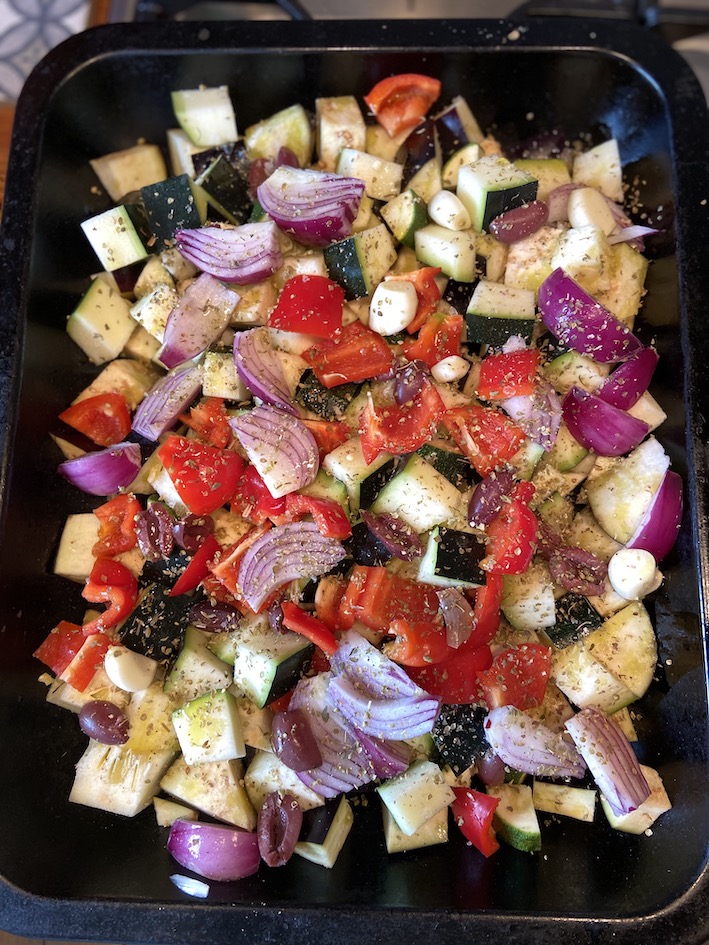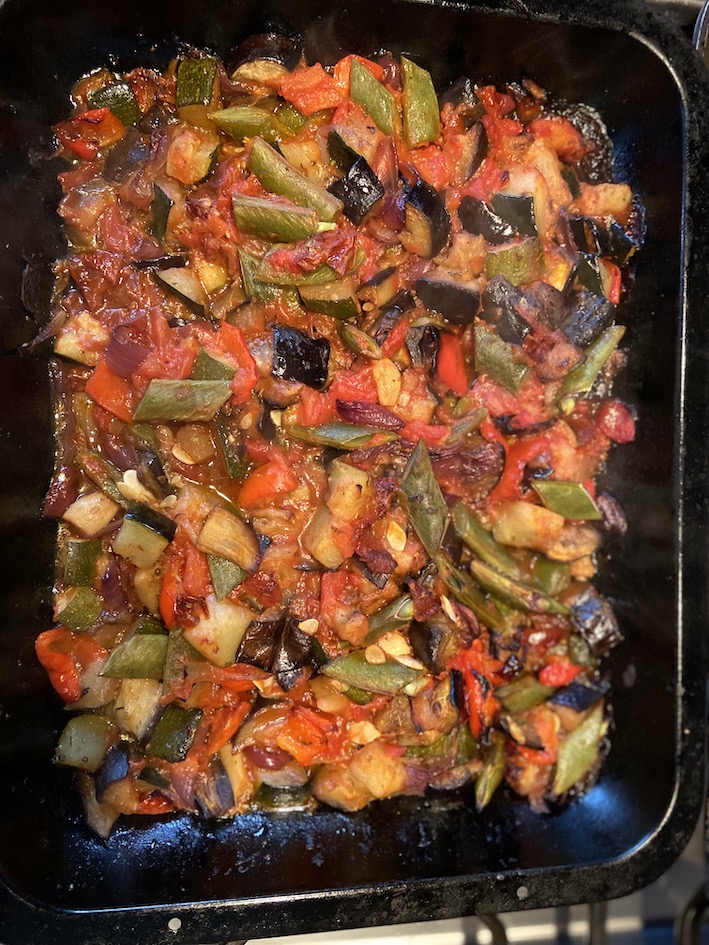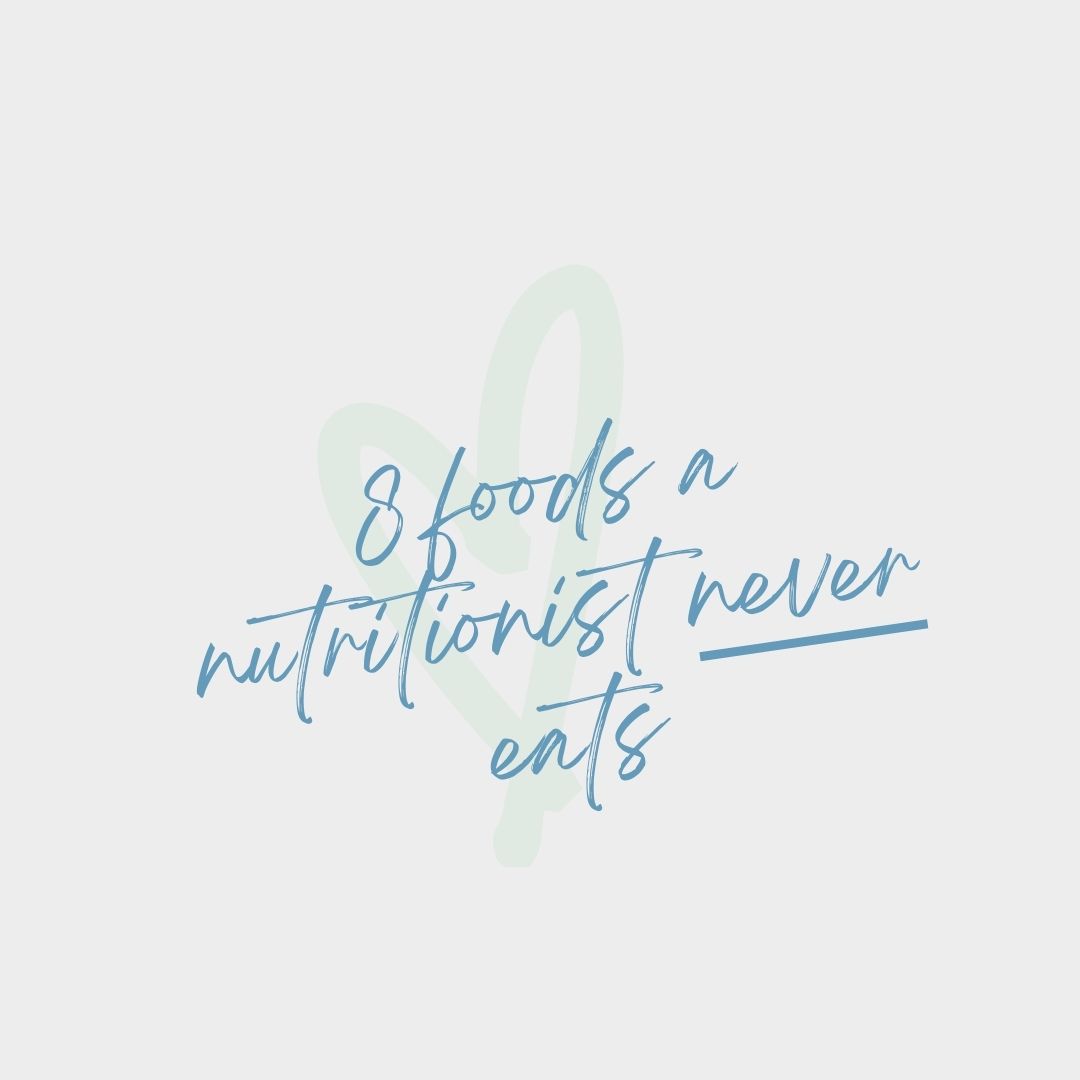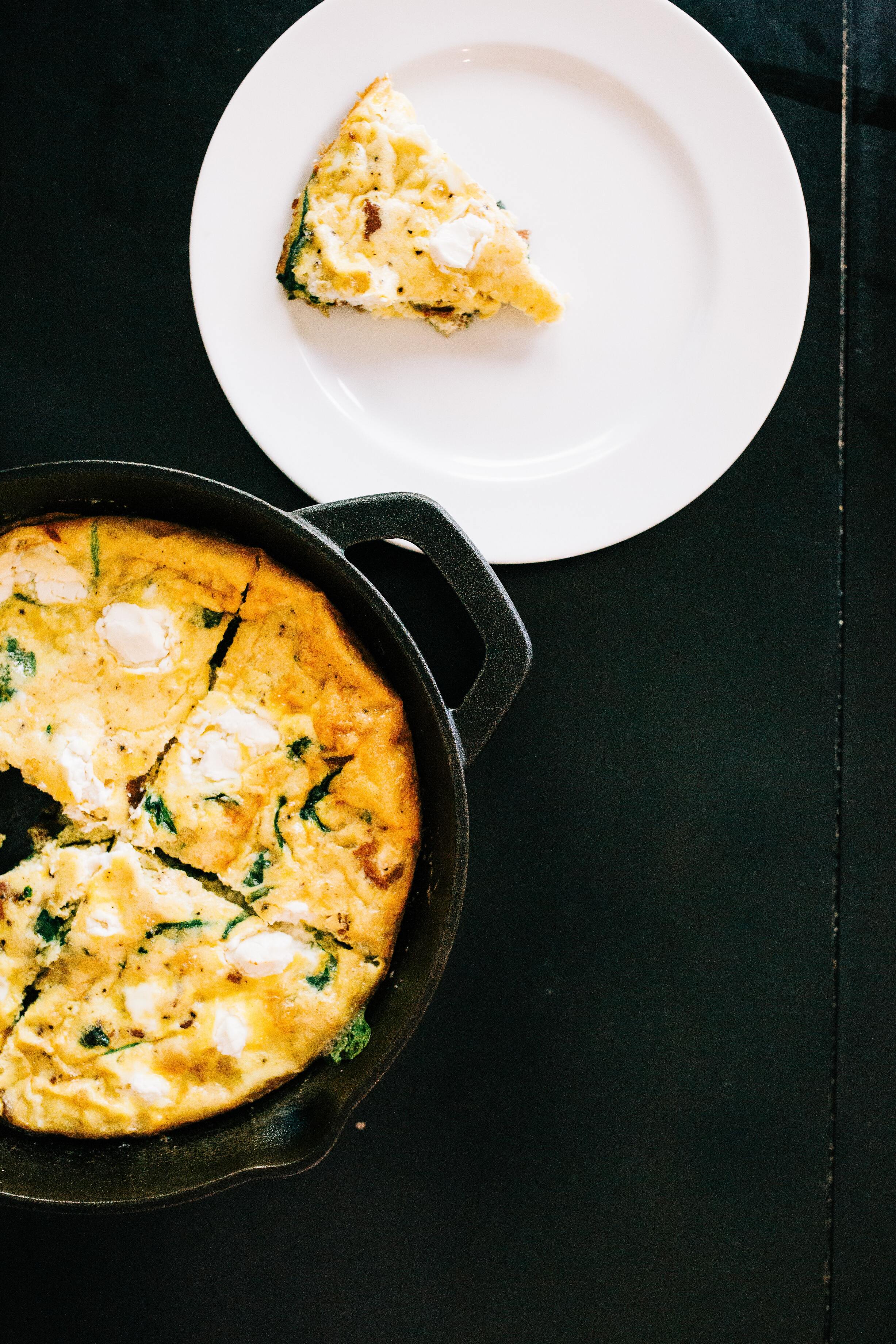

OVEN-BAKED RATATOUILLE
This is a family favourite and a great way to use up a glut of courgettes if you have them! I tend to make multiple batches of this, as it freezes quite well and then you can bring it out a later date.
It goes really nicely with chicken or white fish, or for a veggie option you can add some chickpeas or puy lentils. Yum!
Ingredients:
3 x aubergine, cut into bite-size chunks
6 x courgette (or one giant marrow of a courgette!), cut into bite-size chunks
8 x red onions, cut into 1/8s
3 x red peppers, sliced
1 bulb garlic, peeled and cloves left whole
1 jar olives
Herbes de Provence
Olive oil
Seasoning
Green beans, sliced diagonally
3 x tins chopped tomatoes
Method:

Do you have symptoms such as always feeling tired, constant pangs of hunger, inability to lose weight, sugar cravings all the time, fatigue after meals, central weight gain, and generally just feeling rubbish?
Well, you just might be suffering with insulin resistance – this is one of the main symptoms I see in perimenopausal and menopausal women (hello menobelly!), but it is also one of the main drivers of PCOS.
If you think you might be suffering with insulin resistance, here are my top tips to help you get back to feeling well again:
These foods are the main trigger for insulin production, as your body needs the hormone insulin to move the glucose from these foods out of your bloodstream.
Reducing your intake of these kinds of foods can improve your insulin sensitivity as you won’t need to produce as much insulin.
Firstly, ditch all those sugary snacks entirely – you really don’t need them. I’m talking cakes, biscuits, ice cream, sugary drinks, desserts. And then think about the quality and the quantity of complex carbohydrates that you’re having.
Maybe replace your big bowls of spaghetti with some courgetti or think about eating steamed new potatoes instead of jacket potatoes.
Stress is a major contributing factor to your blood sugar balance. When we are stressed, our body switches into ‘fight or flight’ mode so that we can battle or evade danger.
One of the things that happens is the stress hormones we produce encourage our body to break down its energy stores into glucose, so that it will enter our bloodstream and be ready for fuel for our muscles.
However, if this stress is constant rather than acute (I’m thinking work or family stress as opposed to facing a tiger), then we can end up with persistently high blood sugar levels ergo high insulin and, bam, possible insulin resistance.
Whilst we can’t always change or remove the stressors in our lives, we can learn to build resilience to those stressors. Yoga, tai chi and meditation have been shown in research to help build stress resilience. Something to think about adding to our daily routines.
We all know that sleep is great for our health! But studies have linked poor sleep to reduced insulin sensitivity.
Our body does a lot of repair and resetting work while we sleep, so if we are not having enough sleep, this work won’t be getting done.
Research shows that how much a person sleeps impacts both their insulin and their cortisol (stress hormone) levels, thereby affecting their insulin sensitivity. Aim for 7-9 hours per night, but with a regular sleep and wake-up time.
Regular exercise is an excellent way to improve our insulin sensitivity. It helps us move sugar into the muscles for storage and it immediately improves our insulin sensitivity for up to 48 hours dependent on the type and duration of exercise undertaken.
While both weight training and aerobic exercise have been seen to be beneficial, research shows that it’s a combination of both that is most effective in increasing insulin sensitivity.
Replacing refined carbohydrates with more veggies makes sense when we want to be healthy, doesn’t it?
But eating more veg can make us more insulin sensitive too. Firstly, many vegetables are excellent sources of fibre, particularly soluble fibre.
Soluble fibre feeds the friendly bacteria in our guts and having a balance microbiome has been linked to increased insulin sensitivity. Brussel sprouts, avocados, broccoli, black beans and sweet potatoes are all good sources.
So, these are my tips to getting you back on track! Try them out and see if they can help relieve your symptoms, particularly if you are suffering with PCOS, perimenopause symptoms, or you just can’t move the weight around your midriff. Or why don’t you book in a free 30-minute health review with me – just click here.

September is PCOS or Polycystic Ovary Syndrome Awareness Month. This is a condition which research shows affects over hundred million women worldwide, easily making it the most common hormone disorder of women in reproductive age and quite possibly the leading cause of infertility in women.
PCOS is a bit of a misnomer, as not everyone with the syndrome has polycystic ovaries, and not everyone with cysts on their ovaries has PCOS! Plus, the ‘cysts’ that women with PCOS have are not the same as cysts that may need to be removed. Rather they are where the ovarian follicles have not gone through the maturation process and have failed to reach ovulation stage leaving ‘cysts’ on the ovaries.
The way to officially diagnose PCOS was finally updated last year, and a three-step process is now recommended:
*eg Cushing’s syndrome, adrenal tumours, hypogonadotrophic hypogonadism, usually due to low body fat or intensive exercise, etc.
Alongside the ‘cystic’ ovaries and irregular/absent periods, there are several other symptoms which may denote PCOS:
These symptoms can be hugely debilitating and, in addition to these troubling symptoms, PCOS is associated with a long-term risk of diabetes and heart disease.
While the exact cause of PCOS is not fully understood, there are certain contributing factors:
But don’t despair! The good news is that research shows that changes to nutrition and lifestyle may help with the severity of symptoms.
Decrease levels of refined carbohydrates like sugary treats, bread, pasta, cakes, biscuits, etc.
Insulin’s role is to allow cells of the body to take in blood sugar (glucose) to be used as fuel or stored as fat. However, if there are high levels of sugary foods and drinks or refined carbohydrates (hello bread!) in our diets, our bodies need to keep producing lots of insulin.
Research shows that high levels of insulin in women with PCOS may cause the ovaries to overproduce testosterone, triggering our unwanted symptoms. Moving to a diet that is lower in these sorts of foods, but high in veggies, fibre and good quality protein can be helpful.
Include healthy fats and avoid unhealthy ones
Research shows that foods rich in omega-3 fatty acids, such as oily fish, like salmon, mackerel, and sardines, may be protective against increased PCOS symptoms due to the anti-inflammatory effect that they have on our bodies.
Plus, by avoiding trans-fats, those fats that can be found in deep-fried foods such as chips or crisps, or in shop-bought foods which contain partially hydrogenated fats/oils or shortening, can help reduce the inflammatory effect they have on our bodies. Inflammation, when our immune system is constantly activated, may be a trigger for PCOS.
Increase vitamin D-rich foods
Research shows that many women who suffer with PCOS have low levels of vitamin D. Vitamin D is a hugely important nutrient for us and does many essential jobs, including helping us to balance blood sugar and reduce inflammation; and research shows that adequate vitamin D levels are important for the development of healthy eggs and fertility.
Decreasing levels of stress – emotional, mental, physical
Stress hormones, such as cortisol, are hugely important as an essential part of our response to stress and/or fear and kickstart several body processes which aim to increase our chances of survival.
While this is great in the short-term, if the stress continues and becomes chronic, then this is where it can have a knock-on effect to our hormones, exacerbating our symptoms of PCOS. Ensuring that our blood sugar is balanced and that we are not over-exercising (very common in ladies with PCOS) can help to manage our physical stressors.
Plus, ensuring that we include quality self-care including yoga, meditation and time-off will help with mental stressors and to build stress resilience.
If PCOS symptoms are impacting your life, why not get in touch with me to discuss how a personalised nutrition plan might help? Book a free 30-minute health review today – just click here to book.

8 Foods Nutritionists Never Eat
There is an argument that all foods are OK in moderation, and this is largely based on not having ‘being healthy’ become something that feels a chore or that has you missing out on some of the things you really enjoy.
But as a nutrition professional, there are a few things that I NEVER eat.
1 Reduced fat foods / diet foods
These foods are, by definition, very highly processed. Where fat is taken out of a food, what nearly always goes in instead is either sugar or artificial sweeteners. The idea that fat is bad or leads to weight gain has now been acknowledged as being entirely wrong. We now know that sugars (and excess starchy carbs) are what mostly leads to weight gain and keep you craving sweet things. Many artificial sweeteners aren’t great for gut health either. I’d far rather stick to the natural, full fat version.
2 Margarine and butter substitutes
Margarine and vegetable spreads are the nutritionally poorer relations of real butter, coconut oil and other healthy fats like olive oil. Again, they are heavily processed. Often what draws people to them is the thought that they are somehow healthier because of their lower levels of saturated fats. Given that saturated fat is not the enemy to your health – while artificially hardened vegetable oils (think trans-fats) are -, it’s far better to stick to unadulterated fats, using ghee (clarified butter) and coconut oil, or olive oil for cooking at lower temperatures.
3 Sugar free fizzy drinks, diet drinks and energy drinks
Sometimes I see clients ‘filling up’ on diet drinks, which (although they contain no actual calories) are doing your body no favours. They’re still conditioning your body to expect more sweet stuff, and the jury is still out on whether artificial sweeteners are not great or seriously detrimental to health. Energy drinks often provide a dual hit of very large amounts of caffeine accompanied by either a lot of sugar or artificial sweeteners. When I’m working with clients who are propping themselves up with these drinks, I like to get to the cause of their fatigue, because what’s in the tin of Red Bull (or similar) will not be helping.
4 Hotdogs and processed meat
It is quite shocking how little actual meat goes into hotdogs, and processed deli-style meats are often pumped with water, sugar (even if it’s not actually called sugar, look out for anything ending in ‘-ose’ – like dextrose) and preservatives. Some of the additives in processed meats have been linked to increased risk of colon cancer. If my family demand ham, it’s pretty easy to pick up a small ham joint and cook it myself.
5 Shop-bought cereals
Most supermarket cereals are filled with sugar and very high in starchy carbs, which will have your energy levels crashing come mid-morning. Better options include home-made granola (like the cinnamon pecan granola from Deliciously Ella), which are easy weekend jobs and last a good while, porridge or overnight oats, omelettes or poached eggs (in fact, any kind of eggs) on wholemeal toast.
6 Rice cakes
These are often a go-to food for anyone counting calories. Unfortunately, they will skyrocket your blood sugar levels. A better choice would be a couple of oat cakes topped with unsweetened nut butter or a little hummus.
7 Agave nectar / syrup
Agave syrup comes from a cactus, and the syrup is made from the pulp of the leaf. It’s very highly processed and is mainly fructose, which needs to be processed by the liver, causing more stress for an already over-worked organ. Fructose is actually worse for you than glucose (which is effectively what we are talking about when discussing ‘blood sugar’). Agave syrup (or nectar) is very similar to the (deservedly) much-demonised high fructose corn syrup, that has contributed greatly to the obesity epidemic in the US. My advice? Do not use it!
8 Mycoprotein like Quorn
Quorn is a very processed food that comes from a fungus Fusarium venenatum and is fermented. It has a lot of other ingredients added – like flavourings, yeast, starches and colourings, gluten to give it the texture and flavour of meat. Lentils, pulses, tofu and tempeh are a much healthier alternative if you’re after vegetarian choices.
9 Fruit Juice
The easiest way to get lots of sugar into your system in a short space of time is by drinking it. And since it comes in as liquid, the body doesn’t register it as “eaten”, so it cunningly slips past any detectors that might otherwise signal satiety or ‘satisfaction’. Fruit juice – particularly when freshly squeezed – certainly contains lots of lovely vitamins and minerals, but it contains just as much sugar as that can of Coke. So, don’t kid yourself: fruit juice is not healthy. If you want fruit, eat fruit. Don’t drink it.
Did any of these surprise you?

MEDITERRANEAN FRITTATA
This is a fantastic quick and easy protein-rich lunch. Plus, you can make it in advance and stash it in the fridge. If you cook it in an individual muffin tray, then you get mini frittata which are perfect for packed lunches or picnics.
Serves 2
Ingredients:
200g baby spinach
1 tbsp olive oil/coconut oil
1 onion, thinly sliced
40g black olives, pitted and halved
6 free range eggs, lightly beaten and seasoned with salt and pepper
115g feta cheese, cubed
Method:
1. Wilt the spinach in a covered saucepan for 2 to 3 minutes. Squeeze out any excess water.
2. Heat the oil in an ovenproof frying pan and fry the onion until soft.
3. Pre-heat the grill to medium while the onions are cooking.
4. Spread the onion, spinach and olives over the base of the pan.
5. Pour the eggs over the mixture and scatter the feta on top.
6. Set the base by cooking over a moderate heat for about 5 minutes.
7. Cook the top of the frittata under the grill for about 3 minutes, until golden. Serve with a fresh green salad seasoned with lemon juice and olive oil.
8. Enjoy!

I love Bank Holiday weekends! A time to reconnect with family and friends, but it's also a signal that we're coming to the end of the summer.
Whatever your plans are this weekend, check out my top tips for navigating it wisely.
Tip 1: Don’t go Crazy
It can be tempting to go crazy over the Bank Holiday weekend, thinking you’re going to get back to your healthy lifestyle in September.
Instead, how about setting realistic goals over the weekend regarding alcohol, sugar and movement? Think maintenance rather than putting your head in the sand.
Tip 2: Have a Plan Before You Go Out
I’m not suggesting that you have a complete itinerary for your Bank Hol weekend, we all love a bit of spontaneity, especially when the weather is good!
But if you have current health goals - what is the best way to keep these ticking over? Think about what you might eat when you’re out, how many drinks you’d like to have, what movement you can get in.
Tip 3: Watch Your Portion Sizes
Buffets and barbecues are fantastic, and a great way to share food with lots of people.
But beware of portion creep - we can easily eat two or three times more than we are intending too! Grab your plate and fill it to normal portions - ideally 1/4 plate carbs, 1/4 plate protein and 1/2 plate veggies. Resist the temptation to go back for more if you’re not hungry.
Tip 4: Could You Have One No-Alcohol Day?
Even without full-sugar mixers, alcohol is just plain sugar and may contribute to brain fog, low energy and weight gain if you go crazy.
Try to give your liver a day off over the weekend and limit the damage you do the rest of the time by choosing drinks wisely.
Tip 5: Add in Some Movement
Encourage everyone to get out for a walk after the barbecue! It can be tempting to sit around chatting all day, but just a ten-minute walk can help improve our blood sugar balance.
Get the kids out, take the dog for a walk, everyone will be grateful for a little movement!
And if you’d like to get your September started in the best possible way, why not book a free 30-minute health review with me today? Just click this link.
![]()
Please get in touch and find out more - I offer a free 30-minute exploratory call.